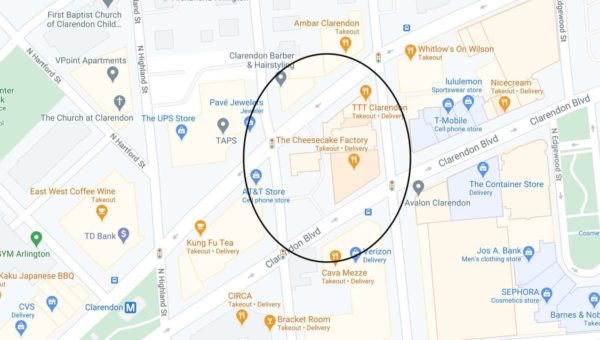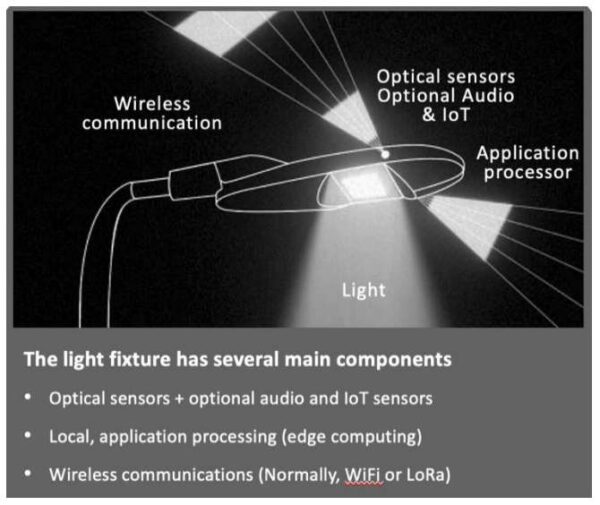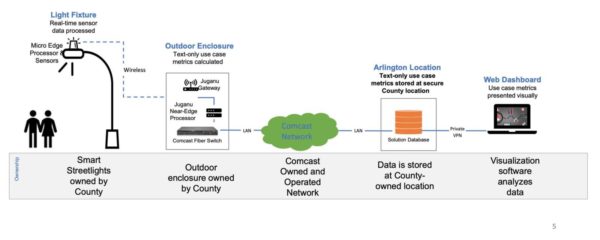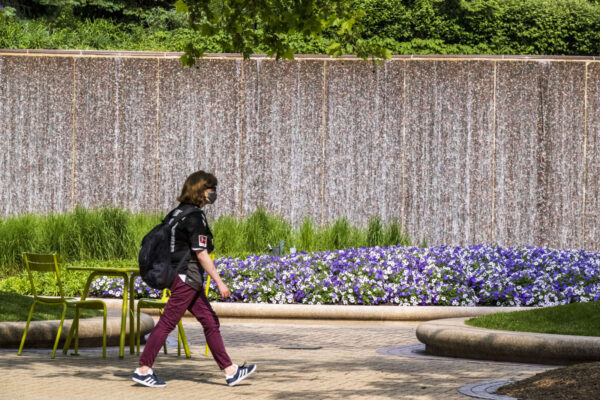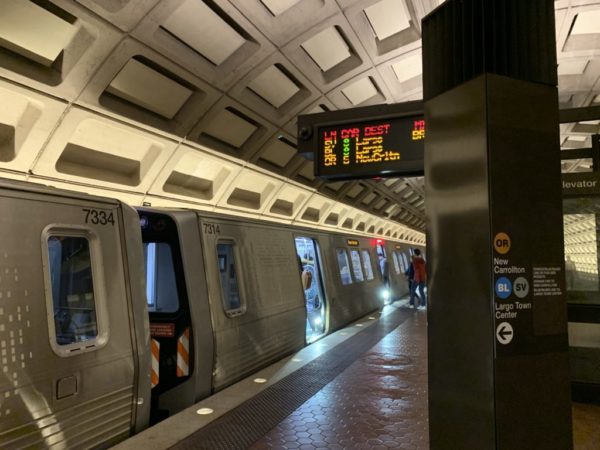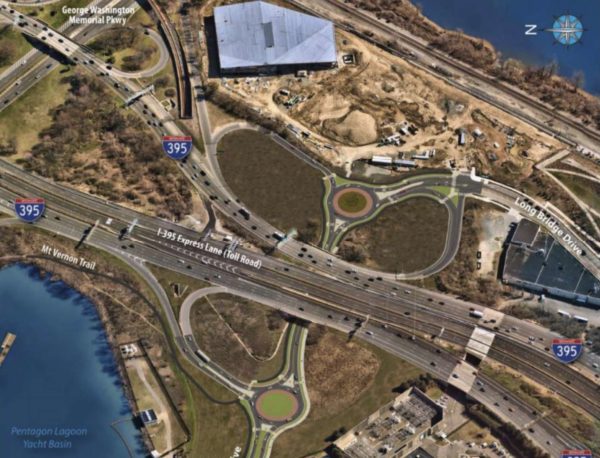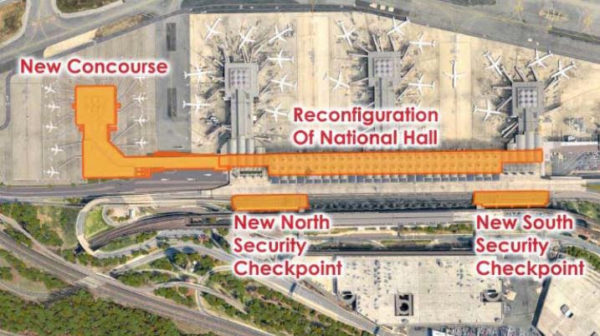A 50-year-old bridge over I-395 near Shirlington is slated for upgrades next year.
Locals can learn more about the planned bridge work next Tuesday evening during a virtual meeting hosted by VDOT, which is managing the project.
The bridge connects the southbound I-395 collector-distributor lanes and southbound Shirlington Road to N. Quaker Lane at the I-395 Exit 6 interchange.
First constructed in 1973, the bridge needs upgrades to improve safety for drivers and to extend its usable lifespan, says VDOT. Today, the bridge is crossed by about 7,400 vehicles daily.
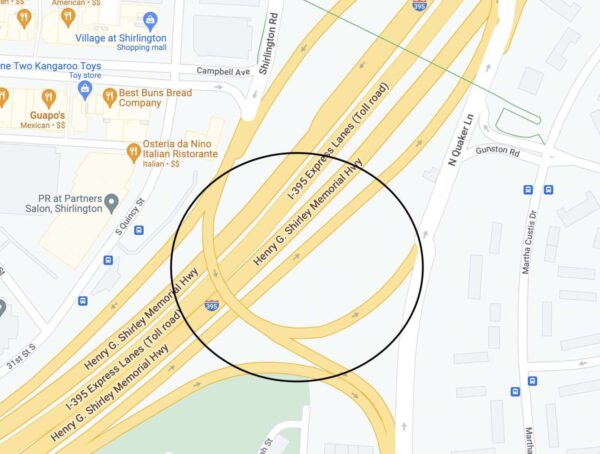
According to the project webpage, VDOT will:
- Resurface the concrete bridge deck and closing deck joints
- Repair concrete piers and abutments
- Repair and repaint steel beams
- Add protective concrete barriers adjacent to piers
- Replace bearings
- Upgrade guardrails adjacent to the bridge
The $4.3-million project will be financed with federal and state funding, including State of Good Repair funds used for bridges.
Next Tuesday’s meeting will begin at 7 p.m. VDOT staff will make a short presentation and then answer questions from the public for an hour. Project materials, which are not yet available, will be posted on the meeting webpage before the meeting starts, the department says.
Through Friday, March 25, VDOT will accept feedback via email and U.S. mail, addressed to Vicente Valeza, Jr., P.E., Virginia Department of Transportation, 4975 Alliance Drive, Fairfax, VA 22030.
The Mount Vernon Avenue bridge is a vital link between Alexandria and Arlington, but it’s in rough shape and in desperate need of a refit.
This morning (Friday) Sen. Mark Warner and local leaders met with engineers to review the state of the Arlington Ridge Road/Mount Vernon Avenue bridge and advocate for it to get a significant boost from federal funding. Federal funding for bridge infrastructure is currently in the hands of state leaders who will allocate funding to bridge projects around the state.
Greg Emanuel, director of the Department of Environmental Services for Arlington County, led Warner and other leaders on a tour of the bridge and highlighted where the issues are. Beneath the Arlington side of the bridge, where the Four Mile Run trail runs, Emanuel said the superstructure will require replacement to the tune of around $28 million.
The nearby West Glebe Road Bridge is in a similar state of disrepair and Emanuel said Alexandria and Arlington are working together for bridge replacement over the course of this year and into 2023. Once that’s completed, Emanuel said Arlington and Alexandria will turn their attention to the Mount Vernon Avenue bridge in the 2024-2025 timeframe.
Emanuel said the current bridge is comprised of stacked slabs of concrete that are difficult to inspect without taking the bridge apart. While the piers and abutments holding up the bridge will remain, an inspection in 2018 found that parts of the roadway superstructure have deteriorated and need to be replaced with a steel bridge — which Emanuel noted will also be easier to inspect.
As part of a new infrastructure bill, Virginia is receiving $537 million for bridge repair. Of the bridge replacement’s $28 million estimated budget, up to 80% of that can be paid for from that federal funding that the state is currently divvying up.
“What we don’t want in Virginia is what happened in Pittsburgh a week ago,” said Warner. “Help is on its way for additional funding.”
Local leaders said more state and federal support for the bridge repair projects would be greatly appreciated.
“Bridges are about connecting communities,” said Arlington County Board Chair Katie Cristol. “We do have a plan to address [the bridge repair] but could use federal support. This project will make a big difference and improve connectivity between low-income communities.”
Alexandria City Council member John Chapman said he grew up around the area and saw little difference as a local between the Alexandria and Arlington sides of Four Mile Run. Chapman said residents on both side of Four Mile Run need to be able to move seamlessly from one side to the other.
“This is a great opportunity to show we caught something before it became a problem,” said City Council member Sarah Bagley. “Inspections are vital.”
Emanuel said localities are currently waiting for more announcements from the state on how the federal funding will be allocated, but Emanuel said the bridges that are in poor condition — which the Mount Vernon Avenue bridge qualifies as — will be first in line for funding.
Despite Gov. Glenn Youngkin getting a less-than-warm reception in Alexandria yesterday, Jennifer Deci, Youngkin’s Deputy Secretary of Transportation, was a welcome presence at the tour and said that state leadership was eager to work with federal and local partners to fund bridge projects and seek more infrastructure funding from the federal government.
Deci said the timeline for allocating the bridge funding is still being worked out, but will likely be sometime in the first half of this year.
A technology initiative to help Arlington emergency responders — by relying on the heat mapping of crowds — is expected to ramp up next month.
The pilot program looks to equip streetlights with sensors on the 2900 block of Wilson Blvd, feeding information to county emergency operations staff and allowing them to monitor potential incidents while helping first responders.
“This means that emergency responders will have more information and more knowledge about an event when arriving upon a situation,” Holly Hartell, assistant chief information officer for strategic initiatives with Arlington County, said in an email.
The sensors won’t provide images of individuals but instead will help with counting people, bicycles and vehicles, according to the county. The devices in the pilot will also be able to gather changes in temperature, relative humidity and air quality, the county says.
Sketch images will be gathered during a one-week testing period to compare actual crowd sizes to an algorithm connected to the sensors, but no images will be captured after that time, Hartell said.
The sensors will be on a wireless network, and non-visual metadata will be anonymized, aggregated and eventually sent to the county’s Open Data Portal and Emergency Operations Center watch desk, a room next to the county’s main dispatch floor that’s typically used for monitoring larger events.
Hartell said the installation and testing of the sensors are scheduled for mid- to late-June. Information gathered by the sensors could be shared on the county’s Open Data Portal as early as this fall.
The project initially considered gathering other kinds of data, such as logging information from nearby Bluetooth-enabled devices like mobile phones, but decided on optical sensors to maximize privacy protection, a county FAQ guide says.
“Arlington County has ownership and full authority over what data is collected,” the county noted in the FAQ.
The county says the technology could improve medical and other public safety response times, as well as awareness of erratic and unexpected incidents.
The project comes through a partnership with Comcast, the nonprofit U.S. Ignite and the state-funded Commonwealth Cyber Initiative.
“To launch the demonstration project, the County is accepting a donation of approximately $90,000 from the project partners,” the county said. “The County’s estimated contribution to the project is $13,601 for contractual services needed to mount and maintain the proposed light fixtures throughout the demonstration project.”
The yearlong demo could also help county officials consider using the technology at other locations in the future.
Photo 1 via Google Maps, photo 2 via Arlington County
New County Infrastructure Plan Proposed — “County Manager Mark Schwartz has proposed a $1.25 billion three-year Capital Improvement Plan (CIP) that focuses on meeting Arlington’s existing commitments, increasing infrastructure maintenance, and beginning investments in long-term plans and programs. The three-year proposal follows a one-year CIP that was adopted last summer as a result of the COVID-19 pandemic. The County anticipates returning to a traditional 10-year plan next year for FY 2023 – FY 2032.” [Arlington County]
Rosslyn Developer Dies from Covid — “Marvin Weissberg, a herald of Northern Virginia development whose portfolio of early projects still mark Rosslyn’s modern skyline, has died. He was 94. The founder of Weissberg Investment Corp. passed away Monday at his home in Annapolis of complications from Covid-19.” [Washington Business Journal]
Marine Corps Marathon Returning — “Good news for runners: the Marine Corps Marathon will take place in-person this year after it was held virtually in 2020 due to Covid. The 26.2-mile race follows a course through DC and Arlington, and typically sees more than 20,000 participants. This year, the marathon and accompanying races and events will be held over the weekend of October 29 through 31.” [Washingtonian]
New Gold’s Gym Opening in Rosslyn — “Rosslyn’s newly constructed Gold’s Gym officially opens for members [today], May 20. Located inside Rosslyn City Center (1700 N. Moore St.), this space is nearly 40,000 SF of brand new equipment and modern facilities!” [Rosslyn BID/Instagram]
Cemetery Flyover Planned Today — “Four Air Force T-38 Talon jets are scheduled to fly over the National Capital Region at 1:50 p.m. The formation is part of a funeral at Arlington National Cemetery for retired Air Force Col. George Benoit.” [Patch]
This Year’s Bond Referendums — “Arlington voters will be asked to approve a modest package of bond referendums in November, if County Board members accede to a request made May 18 by County Manager Mark Schwartz. The proposal calls for a bond package of $62.5 million (not counting an expected school-bond request) that would fund Metro, paving, courthouse renovations and Neighborhood Conservation projects.” [Sun Gazette]
President Biden’s $2 trillion infrastructure plan has added a glimmer of hope to those who would like to see an expanded Metrorail system.
The initial planning for the system in the 1960s envisioned a line down the Columbia Pike, ultimately terminating in Annandale, but the proposed line was nixed in order to save on costs. A physical remnant of the planning is a pair of stub tunnels near the Pentagon Metro station, built to accommodate a potential future Columbia Pike expansion.
Decades later, in 2019, Metro published the results of a study that suggested a number of ways to expand the capacity of the Metrorail network, including a second Rosslyn Metro station and tunnel, and a Silver Line expansion down the Pike and up Route 7.
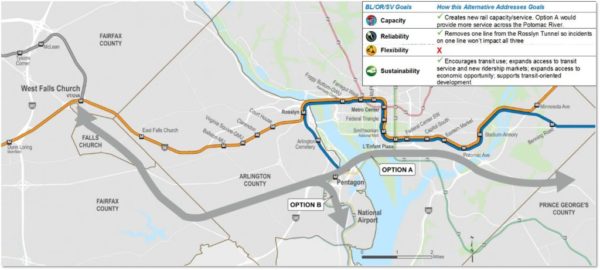
The possibility was especially enticing considering the disappointment of transit advocates following the 2014 cancellation of the planned Columbia Pike streetcar line.
While Metro faces plenty of maintenance, service, budget and ridership challenges — the latter three exacerbated by the pandemic — that hasn’t stopped some from dreaming of a world in which more local residents are within easy walking distance of a light rail commute.
Among those discussing such a possibility, given the massive infrastructure spending that would result should Biden’s plan pass, are some of Arlington’s state lawmakers.
Last session, I put in a budget amendment to study a line along Columbia Pike starting at the Pentagon connecting to East Falls Church. https://t.co/LPMWcRfeLJ
— Patrick Hope (@HopeforVirginia) April 2, 2021
Should have happened years ago https://t.co/n6z54QIPhu
— Alfonso Lopez (@Lopez4VA) April 2, 2021
Even should the stars align and federal funding become available, digging up Columbia Pike and building a new Metrorail tunnel and stations would be fantastically expensive and would likely require a decade or more of planning and construction.
The new connectivity would also result in new development, sharply higher property prices, and other big changes, which could be viewed in a positive or a negative light, depending on your perspective.
What do you think about the idea of a Metro line on Columbia Pike?
A number of major changes are coming to Boundary Channel Drive and the I-395 interchange near Crystal City.
The modifications include a shared-use walkway, pedestrian and bicycle access to the yet-to-open Long Bridge aquatics center, and reduction of four lanes to two.
On Saturday, the Arlington County Board voted to endorse the $20.4 million Virginia Department of Transportation project. It was part of the consent agenda, meaning they are non-controversial and can be acted upon by a single vote.
“We’ve long sought these improvements,” said County Board Chair Matt de Ferranti at the meeting. “They will reconfigure the interchange that you see to make it work a lot better and safer for everyone.”
Major components include adding roundabouts on each side, as well as building a 12 foot shared path that connects to the Mount Vernon Trail, the Long Bridge Park esplanade, and a new loop that goes around the aquatics center. Also along Boundary Channel Drive, there’ll be 8 foot wide sidewalks, landscaping, crosswalks, and street lighting.
A public hearing was held in November where, according to the county report, the public “expressed strong support for the project.”
Much of the feedback revolved around the shared-use path, making sure it was wide enough to accommodate both pedestrians and bicyclists safely. There were also a number of comments about the crosswalks and proposed safety measures.
The project is funded by a combination of state, federal, regional, and county money. Construction is expected to start in spring 2022 and be completed in fall 2023.
Construction of the Long Bridge Park Fitness and Aquatic Center, meanwhile, is still expected wrap up later this year, according to the county website. The upcoming FY 2022 county budget will decide when it ultimately opens to the public.
Image via VDOT
A pedestrian tunnel under Route 1 in Crystal City is too difficult to maintain, county officials say, so the Arlington County Board is considering a plan to close it.
The closure has been in the works for several years. County staff, VDOT, Arlington police and local business owners are all in support of closing the tunnel, citing “maintenance costs, underutilization, loitering, perceived safety concerns, and the realignment of 23rd Street per the Crystal City Sector Plan.”
That’s in addition to complaints that the tunnel is “aesthetically displeasing,” infrequently used for its intended purpose, and often confused for a Metro station entrance.
At its Saturday meeting, the County Board will consider approving resolutions and agreements with VDOT that would lead to the tunnel being permanently closed and dismantled, at a cost of about $300,000 to the county and $87,500 to VDOT.
County staffers say the tunnel, which links either side of busy Route 1 at the 23rd Street S. intersection, costs Arlington about $20,000-25,000 to maintain annually. The maintenance costs include pressure washing areas where people have urinated and repairing “occasional vandalism.”
“The 23rd Street Merchants and the Crystal City BID have routinely complained to County staff and the County Board concerning loitering, public urination, and the unattractive nature of the 23rd Street Tunnel and canopy,” the staff report says. “Observations by County staff showed over 95 percent of users cross at grade as opposed to using the tunnel.”
“The tunnel is generally avoided by pedestrians due to the perception of it being a public safety risk,” the report goes on to note. “Merchants believe that this is having a negative impact on their business district.”
Not everyone is in favor of closing the tunnel, however. From the staff report:
The Aurora Highlands Civic Association submitted written comments requesting that the tunnel remain open with increased cleaning, improved lighting and signage, and added security. The Chair of the Pedestrian Advisory Committee also expressed reservations about closing the tunnel unless improvements to the at-grade crossings were made at the same time. As an additional note, there have been two reported pedestrian/vehicle crashes in the past five years at the intersection. Both were classified as “non-incapacitating injury” crashes.
Despite pushback from the nearby neighborhood association, officials say planned improvements to the intersection over the next few years, detailed below, will further negate the need for the tunnel.
DES has identified some minor improvements to the at-grade crossings that will be implemented during the construction of the 23rd Street capital improvement project between Richmond Highway and South Eads Street, scheduled for late 2019.
- 23rd Street will be narrowed between South Eads Street and Richmond Highway to decrease crossing distance at the intersection with Richmond Highway;
- The crosswalk on the west side of Richmond Highway at 23rd Street will be upgraded to current standards: asphalt and high-visibility thermoplastic markings; and
- Curb ramps will be upgraded on the west side of Richmond Highway at 23rd Street to be accessible per the Americans with Disabilities Act (ADA).
Additional improvements will be made when 23rd Street between Richmond Highway and Crystal Drive is reconstructed, scheduled for 2022.
- The Crystal City Sector Plan anticipates the realignment of 23rd Street to the south, creating a shorter crossing distance at the intersection of Clark Street and Richmond Highway;
- New pedestrian respite areas will be installed in the median of Richmond Highway;
- Curb ramps will be upgraded to be accessible per ADA standards at all crossings (not previously improved by phase 1 above); and
- New traffic signals will be installed per the new roadway geometry and include pedestrian push-buttons at each ADA ramp location
Improvements are planned for a one-way bridge linking eastbound Route 50 to Wilson Boulevard in Seven Corners.
The bridge is blocks away from Arlington’s western border with Fairfax County.
A new concrete bridge deck, steel beams, and concrete end walls have been proposed for the bridge, which was built in 1958, as well as upgraded bridge railings.
A new sidewalk would be installed along the opposite side of the bridge’s existing sidewalk, which would be rehabbed.
A public information meeting with project displays and a presentation by Virginia Dept. of Transportation staff is planned for Tuesday (April 3) from 6:30-8:30 p.m. at Sleepy Hollow Elementary School (3333 Sleepy Hollow Road, Falls Church).
Public comments can be given at the meeting. Project financing comes from state and federal infrastructure funds.
The pedestrian tunnel that crosses Route 1 in Crystal City will eventually be removed as part of the 23rd Street alignment project, though a scheduled closing has not been set.
The project, which is several years out, will “accommodate redevelopment on the east and west intersections of 23rd Street S. between Crystal Drive and S. Clark-Bell Street” in two phases. (Clark and Bell streets are also being realigned and merged into one.)
The tunnel may be closed before the project begins, “because it is underutilized” and because of upkeep costs, according to a county spokesperson. The tunnel was intended as a safety improvement, though many locals take their chances at street level due to the tunnel being dark and smelling like urine.
Robert Mandle, Crystal City Business Improvement District’s chief operating officer, cited several reasons for the change, including increased visibility for the row of restaurants along 23rd Street S. and what he called the “surprisingly common misconception that the tunnel will take you to Metro.”
“The interest in closing the tunnel really arises from the fact that most people use the surface crossing because the tunnel is longer, indirect, and uncomfortable,” Mandle wrote in an email to ARLnow. “Recent safety enhancements completed by Arlington County have further improved the existing signalized crossings.”
Travelers heading to or from Reagan National Airport should get ready for traffic impacts from construction starting next week.
Work will begin overnight from Monday, February 19 into Tuesday to prepare the building foundation for the new security checkpoints.
Roadway disruptions will initially be confined to overnight lane closures near terminal B/C, but will extend into the afternoon and evening hours later in the spring.
A project press release adds that “some temporary changes are coming inside the terminal that will affect the airline check-in process for some passengers.”
Nicknamed “Project Journey,” the one billion dollar infrastructure enhancement is scheduled to run through 2021. The finished project will bring two 50,000-square-foot buildings with security checkpoints, replacing three smaller checkpoints at terminal B/C. A new 14-gate concourse is in the works, which will include an American Airlines members lounge, replacing the notoriously difficult to access Gate 35X.
The airport has vastly outgrown its original passenger projections. It now serves about 24 million travelers a year, as opposed to the 14 million it was built to accommodate.
(Updated at 2:05 p.m.) Arlington County’s plan for a Columbia Pike corridor “premium bus service network” will start this summer, with more frequent, condensed bus service, improved bus transit stations, and off-vehicle fare collection points in the works.
A Columbia Pike service evaluation briefing from WMATA to the Arlington County Transit Advisory Committee on January 16 laid out the major bus service plan: streamlining eleven 16-line routes down to six main routes, with further streamlining implemented in multiple phases.
Current Columbia Pike corridor service routes include the 16A, B, E, J, and P daily lines and the 16 G, H, and K lines, which run from Columbia Heights West through Pentagon City daily. There are also three peak period bus lines: the 16L, which runs from Annandale, Va., to the Pentagon via Skyline City; the 16X, from Columbia Pike to Washington’s Federal Triangle; and the 16Y, from Columbia Pike to Washington’s Farragut Square.
The first phase of the premium bus service network would eliminate the 16E and J lines, while maintaining daily service for the 16A, G, H, and X. Peak period service will continue along the 16L and Y. The 16X’s extension into Federal Triangle would be maintained only during peak periods.
Phase two would maintain the initial phase’s route streamlining, while adding a transfer-free, bus-to-bus Crystal City connection. The evaluation notes the possibility for weekend service for the 26A bus line, which runs from Annandale to East Falls Church, but that component of the plan is still under consideration.
Further route streamlining would occur under phase three, which would maintain the daily 16A and X routes, as well as the peak period 16L and Y routes, but would strike out the 16G and H lines. A new line — a 16M line to run from Crystal City to Skyline City — would be added. Arlington Transit (ART) routes 41 and 45 would continue serving the Arlington Mill and Columbia Pike corridor after the 16G and H merge, according to Lynn Rivers, the Arlington transit bureau chief and the project’s manager.
Phase three opens up the possibility of an extension of the 16X and Y bus routes service hours, but it’s currently marked as a future consideration. The county is also reviewing transit signal prioritization as a bus rapid transit solution to give buses a head start at traffic lights, allowing for decreased public transit times. Rivers told ARLnow.com that this initiative “can be achieved with minimal impacts to vehicular travel.”
Updated bus transit stations are also in the works, with “near-level boarding” and real-time bus tracking and system information. Passengers would be able to pay for their bus fare prior to entering the bus.
Photos via Arlington County


